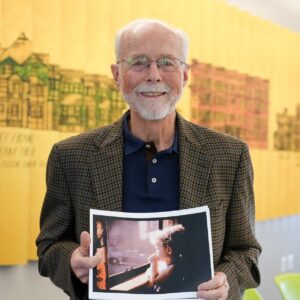The rise and fall of Bunker Hill is one of Los Angeles’ most oft-repeated tales. The neighborhood was established as an elite residential enclave in the late 19th century. As the city expanded to the south and west in the early 20th century, the area experienced a transition to middle and working-class housing. Despite the vibrancy of the neighborhood at this time, the hill was described by local planners and policymakers as a slum. In 1958, Bunker Hill was designated a redevelopment area, and the community was razed. According to official records, at least 8,000 individuals were displaced. This number is likely far greater.
Scholarship has linked the redevelopment of Bunker Hill to national housing policies, cold war politics, and the desire of local elites to shape the image of the city. However, less is known about the individuals and families who occupied the neighborhood before the bulldozers arrived. Since 2020, an interdisciplinary team at the University of Southern California has been working to create an immersive digital model of Bunker Hill. This model, linked to data from a 1939 survey prepared by the Los Angeles Housing Authority, as well as US census records, historical photographs, and other archival materials, will serve as the organizing frame for the Bunker Hill Refrain project. By weaving official records together with stories from individuals displaced by the redevelopment project, the project shifts the usual narrative of mid-century demolition towards a more people-centered urban history.

![]() I’ve waited 40 years for someone to ask me about Bunker Hill
I’ve waited 40 years for someone to ask me about Bunker Hill
[…]
Bunker Hill wasn’t the slum they said it was. The buildings were never abandoned. They were occupied. [The planners] wishes turned into reality.![]()
-Gordon Pattison,
former Bunker Hill resident
While Bunker Hill’s original built environment has been lost, excavating its social history provides the public, planners, and policymakers with a valuable lesson.
Specifically, the project will:
- Contribute to scholarship on Los Angeles history and urban planning by providing a more nuanced understanding of a diverse working-class community lost to redevelopment.
- Advance digital humanities and public history methods by developing an immersive and interactive 3D model incorporating archival data, oral histories, and other ephemera.
- Raise awareness about the social impacts of urban renewal and displacement.
- Promote community-engaged research by involving former residents, their descendants, students, and community organizations.
Bunker Hill Refrain encourages new ways of thinking about community archives, cultural memory, and digital technologies to reimagine the future of marginalized communities. This is particularly significant when considering the demolition of Los Angeles’ working-class neighborhoods through urban renewal during the mid-twentieth century and the ongoing redevelopment and gentrification of cities across America. By engaging with these problematic histories of past and present-day disruptions and by bringing together individuals from community-based institutions representing diverse cultural heritages, the Bunker Hill Refrain project allows the public, planners and policymakers to grapple with the legacy of displacement as it exists today.
